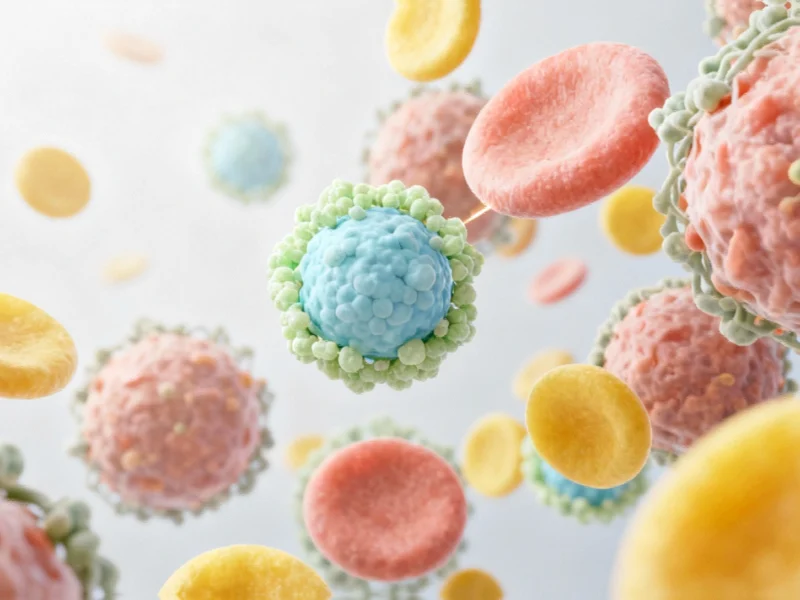In the rapidly evolving field of nanomedicine, researchers are developing increasingly sophisticated methods to deliver therapeutic agents directly to diseased cells while minimizing systemic side effects. This targeted approach has already proven successful in clinically approved RNA-based technologies and chemotherapy formulations, representing a significant advancement in precision medicine.
A critical challenge in this domain involves preventing the body’s immune system from recognizing and eliminating these therapeutic nanoparticles before they reach their intended destinations. Recent findings from the University of Delaware, as detailed in comprehensive coverage of protein coating research, reveal how strategic engineering of nanoparticle surfaces can dramatically improve their ability to evade immune detection and successfully deliver their payloads.
The Protein Corona Phenomenon
When nanoparticles enter the bloodstream, they immediately acquire a coating of proteins known as the “protein corona.” This natural biological response significantly influences how the immune system perceives and interacts with the particles. Professor Emily Day, senior author of the study published in the Proceedings of the National Academy of Sciences, emphasizes that “understanding the influence of the protein corona on a nanoparticle’s fate will help us design nanomedicines that more reliably evade immune clearance and deliver therapies precisely.”
The research team’s innovative approach involved wrapping nanoparticles with membranes derived from bone marrow cells called megakaryocytes. This biological coating proved remarkably effective at modifying the protein corona formation, potentially offering new pathways for targeted drug delivery systems that could complement other emerging technological platforms in industrial applications.
Targeting Elusive Blood Stem Cells
The study focused specifically on hematopoietic stem cells, which represent just 0.01% of bone marrow cells but give rise to all blood cell types. First author Eric Sterin, who recently earned his doctorate in biomedical engineering from UD, explained the significance: “The rarity of hematopoietic stem cells makes them a challenging target. Our membrane-wrapping approach coats nanoparticles with proteins that help guide them to the marrow, potentially enabling more effective treatments for conditions ranging from bone marrow transplant preparation to genetic disorders like sickle cell disease.”
Laboratory and animal experiments demonstrated that membrane-wrapped nanoparticles exhibited distinct advantages over their unwrapped counterparts. These engineered particles bound significantly less protein overall when exposed to blood serum from mice, cows, and humans. Particularly in human serum, the classes of proteins that adhered to the wrapped particles showed notable differences, suggesting a more favorable biological interaction profile.
Mechanisms of Immune Evasion
The research revealed that the sparser protein coronas on membrane-wrapped nanoparticles directly influenced their cellular interactions. In laboratory studies, these modified particles demonstrated enhanced ability to enter target cells while being less readily taken up by immune cells responsible for particle clearance. This dual benefit represents a significant step forward in nanomedicine design, potentially creating opportunities for integration with advanced computing systems that support complex medical research.
Proteomics analyses identified apolipoprotein B as the most abundant protein in the corona of these specific nanoparticles, contrary to previous studies that found apolipoprotein E to be more common in similar systems. Both proteins function as molecular transporters but can also serve as recognition markers that clearance cells use to identify and remove foreign particles from circulation.
The Delicate Balance of Protein Interactions
Using specialized mouse models engineered to lack specific proteins, the researchers uncovered a sophisticated interplay between different corona components. Proteins such as complement component 3 and immunoglobulin G were found to play contradictory roles—simplifying immune clearance to organs like the liver while simultaneously assisting targeted delivery to hematopoietic stem cells in bone marrow.
Professor Day highlighted the implications: “Finding ways to control the levels of these proteins could help shift the balance toward more precise delivery to blood stem cells in the bone marrow and less off-target delivery to other organs.” This nuanced understanding of protein corona dynamics represents a paradigm shift in nanoparticle engineering, potentially influencing how researchers approach automated systems across various technological sectors.
Future Directions and Clinical Translation
The research team is currently investigating methods to fine-tune protein corona composition by modifying components of the membrane wrapping. Future studies will extend to humanized mouse models, which possess human-like immune systems, to better predict how these engineered nanoparticles might perform in clinical settings.
This groundbreaking work not only advances our understanding of nanoparticle-biological interactions but also opens new avenues for developing more effective nanomedicines. By strategically engineering protein coatings, researchers may soon create therapeutic nanoparticles that reliably reach their targets while minimizing immune system interference, potentially revolutionizing treatments for numerous conditions that require precise cellular-level interventions.
Based on reporting by {‘uri’: ‘phys.org’, ‘dataType’: ‘news’, ‘title’: ‘Phys.org’, ‘description’: ‘Phys.org internet news portal provides the latest news on science including: Physics, Space Science, Earth Science, Health and Medicine’, ‘location’: {‘type’: ‘place’, ‘geoNamesId’: ‘3042237’, ‘label’: {‘eng’: ‘Douglas, Isle of Man’}, ‘population’: 26218, ‘lat’: 54.15, ‘long’: -4.48333, ‘country’: {‘type’: ‘country’, ‘geoNamesId’: ‘3042225’, ‘label’: {‘eng’: ‘Isle of Man’}, ‘population’: 75049, ‘lat’: 54.25, ‘long’: -4.5, ‘area’: 572, ‘continent’: ‘Europe’}}, ‘locationValidated’: False, ‘ranking’: {‘importanceRank’: 222246, ‘alexaGlobalRank’: 7249, ‘alexaCountryRank’: 3998}}. This article aggregates information from publicly available sources. All trademarks and copyrights belong to their respective owners.
